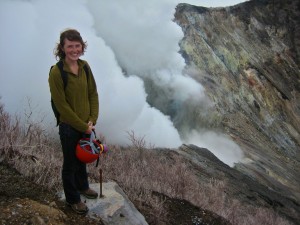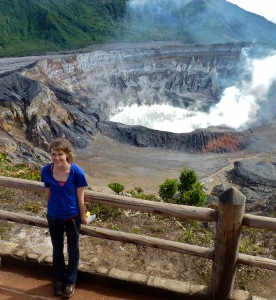Thesis Research: Ocean Fish Consumption, Not Volcanoes, Cause High Mercury Levels in Costa Rica

(Story contributed by Jim H. Smith)
Senior thesis research conducted last spring by Audrey Haynes ’12 at Costa Rica’s National University, under the tutorship of Johan “Joop” Varekamp, has shown that many residents of the Central American nation have levels of mercury in their hair that far exceed those recommended by the U.S. Environmental Protection Agency. Varekamp, whose student made the discovery as part of a broad evaluation of environmental mercury in Costa Rica, says the elevated mercury levels are probably a consequence of over-consumption of large ocean fish, not exposure to mercury in the air emitted by volcanoes, as a controversial 2011 study suggested.
The research was done in collaboration with Maria del Mar Martinez of the volcanology and seismic monitoring center (OVSICORI/UNA).
Varekamp, the Harold T. Stearns Professor of Earth Science, and his student were invited last spring to test Costa Rica’s mercury levels because research conducted by another team of scientists had found levels of mercury in Costa Rican air that were dramatically higher than those documented anywhere else in the world. While the average environmental mercury concentrations worldwide are in the neighborhood of two or three nanograms (billionths of a gram) per cubic meter of air, the 2011 study reported extraordinarily high concentrations of 600-800 nanograms Hg per cubic meter.
“This was puzzling because many small and remote countries that are less industrialized, like Costa Rica, report modest levels of airborne mercury from coal-fired power plants. Costa Rica doesn’t have any coal fired power plants, though, nor does it have any major mercury-emitting industries,” Varekamp explains.

The country is, however, a hotbed of volcanoes. Slightly smaller than Massachusetts, it boasts six active ones and more than 60 others that are dormant or extinct. Since any source of geothermal emissions may elevate local levels of mercury, the volcanoes were implicated in the earlier research.
Since levels of environmental mercury in the air, like those documented by the 2011 research, had never been found anywhere – much less in any other small, modestly-industrialized, albeit heavily volcanic country – Costa Rican officials were understandably concerned. OVSICORI/UNA turned to Varekamp because he’s widely recognized as a leader in the field. Not only is he a renowned geochemist who has explored volcanoes in every corner of the planet, but he has also carved out a special niche as an expert on mercury pollution, which he began studying at Mount St. Helens soon after that volcano’s catastrophic eruption in 1980. Indeed, when he was hired by Wesleyan it was on the strength of that duality. He regularly teaches vulcanology and mineralogy, but he also teaches a course titled “Living in a Polluted World.”
In the nearly three decades since he joined the Wesleyan faculty, Varekamp has studied environmental mercury in many locations. In 2002, he and a group of students detected high levels of mercury in sediment samples from the mouth of western Connecticut’s Housatonic River. They traced the highly toxic metal to the Still River, a Housatonic tributary in Danbury, Conn., which was historically a bustling center of hat production, an industry that used mercury in the production process.
Two years ago, Varekamp and a team of graduate students discovered high levels of mercury trapped in the sediment of the Connecticut River’s Wethersfield Cove, just south of Hartford. They traced the pollution there to a defunct Hartford Electric Light Company plant that used mercury as part of an experimental heat transfer process. Because the liquid mercury was corrosive, equipment in the plant, closed in the mid-1960s, often leaked. Read more about this study in this 2011 Wesleyan Connection article.

Haynes’ study of Costa Rica’s environment was wide-ranging. They analyzed core samples of sediment extracted from several lakes in Costa Rica’s central valley, as well as tissue from trout and tilapia, fresh water fish species common to the lakes. They also tested air from the same areas where the 2011 team had reported exceedingly high mercury concentrations.
“We found no evidence of unusually high mercury concentrations,” says Varekamp. “All of our air findings were well within dispersion model predictions for mercury, and water and fish samples were also what we had expected. The mercury levels in these freshwater fish tissue specimens were well below U.S. EPA alert levels.”
When the scientists tested samples of human hair from 53 residents of the same region, however, they found alarmingly high levels of mercury in more than half of the samples. The U.S. EPA alert level for mercury in hair is 1,000 parts per billion. Three of the hair samples Haynes analyzed had concentrations greater than 8,000 parts per billion. One registered 13,840 parts per billion. By comparison, only 25 to 30 percent of the U.S. population exceeds the USEPA alert level.
When Haynes compared the hair findings with dietary information provided by the subjects from whom the hair samples were obtained, a pattern began to emerge.
“Many of the subjects routinely eat large marine fish, especially tuna, shark and swordfish,” Varekamp says. “These big fish travel great distances and they inevitably have high concentrations of mercury in their tissues. They may have ingested the mercury far away from Costa Rica, so the concentrations of mercury in the fish probably have little to do with geothermal mercury in Costa Rica.”
He notes that in a previous Wesleyan study on the island of Tobago (BA/MA thesis of Asia Neupane ’09), where residents have a diet dominated by marine fish, and in a study of the Chilean coastal area (senior thesis of Navpreet Sidhu ’11), similar concentrations of mercury in human hair were found. “Those findings are also consistent with studies conducted by other researchers on islands and coastal regions,” he says.
While he declines to speculate on why the 2011 research team recorded such strikingly high mercury concentrations in air, Varekamp is quick to suggest that further research should be done in Costa Rica.
“Our results provide some initial insights into mercury as an environmental pollutant in Costa Rica and the particular path of human ingress there,” he says, “but more data should be collected to confirm our initial results. More important, an in-depth study of mercury concentrations in human hair should be undertaken to determine if our sample population is representative of the broader Costa Rican population.”

